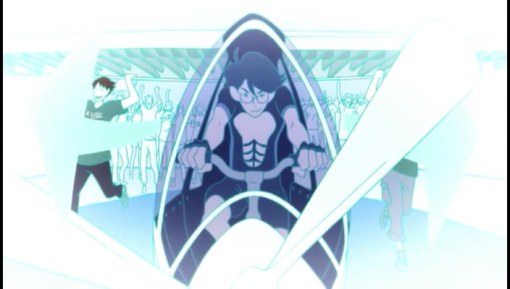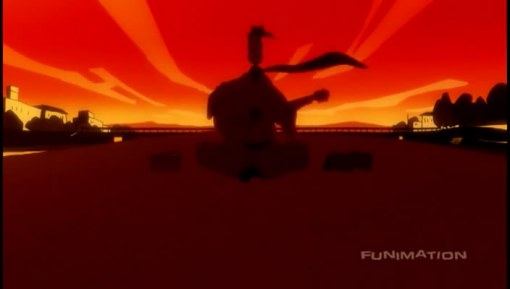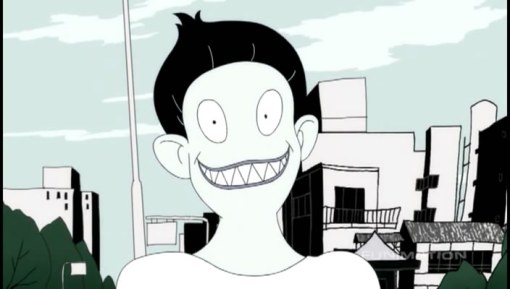…but the idea that you’d go so far as to train didn’t figure into my expectations.”
Tatami Galaxy has begun to settle into a somewhat familiar pattern, but each repetition begins to feel slightly more intense than the one before it. Watashi’s problem starts to come out in the repetition of these two episodes, and as I’ve noted previously, it is the conflict that stems from his own stubborn pride.
“Cycling Club Soleil” aptly illustrates this: Watashi’s issue is that he wants to remake himself to impress others, but Akashi, the girl he cares for, simply wants him the way he already is. The nod to the Greek myth of Icarus, who flew too closely to the sun and melted his homemade wings, is a nice touch that again brings us back to the theme of mythology and recurrent archetypes. The themes here are also very clearly presented and most viewers I feel will be able to piece things together with no trouble, but for completeness’s sake I will review the symbolism:

Note once more the role of stylization - Watashi's dreams are bright and sunny, while most of Cycling Club Soleil is actually very drab and cloudy, ironically enough.
There is a very strong metaphor presented in this episode through Watashi’s “relationship” with his two bikes – his new one, which he describes as his “wings”, and his old worn-down everyday model, which he affectionately names Manami. Later, after the bike theft, he returns to Manami with all the terminology of marital infidelity on display… only to later be disgusted by his sentimentality at his affection towards an inanimate object when he is left in the dust during the race. Later, he meets up with Akashi who promises to literally give him wings by letting him participate as the Birdman contest pilot. Much like in the case of the bikes, however, Watashi thinks of Akashi in a completely one-sided way – the wings that Akashi gives him are his to live up to. In the same way as his biciclyes, Watashi sees Akashi’s help as only additive to his own effort. He must be the one at the end of the day pedaling – Watashi remains the one on top, riding the bike (ho ho, innuendo). What Watashi lacks is the understanding that all Akashi desires from him is to simply sit still and be lifted up by her – something that his pride cannot (at this point) accept. This is amusingly and poignantly hammered home when Watashi asks “Where’s the pedals?” only to be informed that they are competing in the unpowered flight category.
 On another note, it is good to see Jougasaki brought back in this episode as something more of a neutral character, and certainly still a very funny one. The conclusion of this episode, revealing Ozu as having masterminded the taking of Watashi’s bike, throws all previous assumptions for a loop; especially if one has been assuming Ozu to be a psychological phenomena – but more on that at the very end of this post. Overall, “Soleil” ensures we’re familiar with the formula…
On another note, it is good to see Jougasaki brought back in this episode as something more of a neutral character, and certainly still a very funny one. The conclusion of this episode, revealing Ozu as having masterminded the taking of Watashi’s bike, throws all previous assumptions for a loop; especially if one has been assuming Ozu to be a psychological phenomena – but more on that at the very end of this post. Overall, “Soleil” ensures we’re familiar with the formula…

“Disciples Wanted”, on the other hand, shakes things up a little, just in time to prevent the show from becoming too repetitive. The circle in this episode is not so much chosen by Watashi as much as it chooses him – there is no promise of that “rose-coloured campus life” that Watashi sees in his first impression. Ironically enough the triviality of the activity as a “disciple” is as pointless as Watashi’s strivings in the past few clubs, and might in fact have been a good deal more fun. Episode 4 is also framed against the backdrop of (presumably) Jules Verne’s Twenty Thousand Leagues Under the Sea – we see Higuchi/Kamotake reading it constantly, and sticking pins in every part of the globe. His musical song and dance number (a high point of the episode that tickled me immensely) also features the Nautilus erupting from the river.
The sense of repetition continues to get stronger with each episode and reaches a high point in “Disciples Wanted” – characters frequently allude to having seen each other or having done some things before, moreso than a simple repetition of themes: Higuchi winning the Shimogamo Cup, the expose on Jougasaki, and of course, the price-hiking fortune-teller. The plot of “Disciples Wanted” itself follows Watashi as he is selected to succeed Higuch/Kamotake as the heir to an ongoing conflict that began with two students feuding over love, while Ozu of course becomes heir to the opposing side.

Truly an exercise in futility, but all the other circles so far have been just as pointless for our protagonist.
As I noted in my post on Movie Circle Misogi, the animation style is at once both playful and purposeful; this is less used in “Soleil”, but “Disciples Wanted” brings back stylistic depictions with a vengeance, substituting various deep-sea creatures for the various shop-keepers that Watashi flags down in his assigned task, and as mentioned, the spectacular backdrop of the Nautilus. As well, Watashi’s attraction towards Akashi is much more clearly visually displayed:
As always, the animation helps reveal much more about Watashi’s emotional state – it shows, rather than tells.
Kamotake has steadily begun encroaching into the story as a character himself, rather than standing in the background and watching as one would expect of a spirit. In “Movie Circle Misogi”, he is an acquaintance of Ozu, then in “Cycling Club Soleil” he becomes Ozu’s master and the recipient of the bike thefts, and by “Disciples Wanted” he becomes Watashi’s master as well – but in these cases he is referred to as Higuchi Seitarou, not by the name he introduces himself by in the first episode. I can’t help but feel there is a Japanese pun or reading convention in regards to this.
In regards to puns, it’s also interesting that the “mystical tortoise scrubbing brush” that Higuchi asks Watashi to get him has near the same pronounciation as the name he introduces himself by in Episode 1.
We are also introduced to a new character in this episode, and presumably the last major character (if the opening theme is anything to go by) – Hanuki, an older female student who has a fondness for drinking. Much how Jougasaki’s character design presents an hypermasculine alpha pack leader look, Hanuki has elements of almost a completely feminine opposite – sultry, worldly, and seductive – she is the opposite of Akashi in the same way that Jougasaki is the opposite of Watashi.
Ozu’s depiction since Movie Circle Misogi has featured on occasion a raccoon-like tail – a nod perhaps to the trickster tanuki of Japanese myth. And, as the trickster, Ozu is revealed certainly as the continuing constant, the true antagonist if not necessarily a villain. Episode 2 seemed to suggest Ozu as a psychological phenomena experienced by Watashi. Episode 3, with Ozu’s talk of Higuchi as his master, suggests perhaps that he is a divine or at least supernatural servant. Episdoe 4 casts him – most accurately – I think, as Watashi’s foil. What to make of this? It’s irrelevant what Ozu actually *is*, but it’s far more important to focus on what he does in the context of the plot – he is the focal point of all of Watashi’s frustrations. It is Ozu who takes away the bike in “Soleil”, Ozu who traps , Ozu who turns the documentary into a personal attack, and so on and so forth.
There is a constant temptation to try and plot out what is “real” or what is “actually” happening consistent from retelling to retelling – my advice would be to take a pass on that. We’ve fully entered the realm of mythology now, where anything is possible and everything happens at the same time.




May 14, 2010 at 7:42 pm
I haven’t seen these eps. Are you watching them subbed? Which groups do you recommend?
May 14, 2010 at 9:55 pm
I’m keeping abreast of the simulcast schedule for the most part; it seems many subbers have been scared off by the show. Look around for Big Pancake.
May 17, 2010 at 6:13 am
I curse thee, low quality web-streams.
I found episode four to be quite dull for some reason, and I can’t quite grasp why. Perhaps all the Jules Verne stuff just felt a bit thrown in.
May 17, 2010 at 11:47 pm
@Jack – Episode 4 is a little slower I think. We have a lot less madcap action or comedy here – much of the episode is focused on Watashi’s search for the tortoiseshell brush along with Akashi – which in itself is some sort of development, I think. It does feel overall like more of a “setup” episode that others can build on.
May 19, 2010 at 6:44 am
I finally caught episode 3.
I think I got affected by it the most from the episodes so far.
Wasted effort is such a strong theme for me. I have spilled a lot of ink about Sisyphus and his rock, though the episode chose the Icarus story, as a whole Watashi is Sisyphean.
It’s kind of like how I gave a ton of effort to try to win my match in the blogger tournament only to lose by five votes, and now ‘enjoy’ the attention of readers and other bloggers who don’t particularly like me or at least how I do things.
I felt I wasted almost 2 years of university as well, as it wasn’t until my junior year when things really started becoming awesome/dramatic and my world blew up.
Having just finished the ep I think I’m a bit of a mess right now and rather raw. This is a strange show for me, but it got to me good.
May 20, 2010 at 11:59 pm
@ghostlightning – Soleil is certainly a really strong episode and it’s where the show starts to shine the brightest, which is why I think some viewers have felt let down by episode 4.
I’m glad you found the show resonant if not exactly enjoyable, and also thank you for linking out to other sites; makes blogging the series a lot more fulfilling.
May 21, 2010 at 6:21 am
[…] Tatami Galaxy 3 and 4 (Vendredi 05/14/2010) […]
May 23, 2010 at 7:44 pm
You’ve written a wonderful comparison between Hanuki and Jougasaki in contrast to Akashi and Watashi. The third episode, my best of the series, is all about misguided effort – when he should have focused on just Akashi, he also focused more on the development of his self, not even required by her. She just wants him to be himself, but he cannot accept that he is acceptable to anyone because of how and what he is. It is a reconciliation between this acceptance of his self as well as the desire to improve without totally changing the integrity of his being that is what he needs: he does not need a surfeit of blind effort, but he also does not need an excess of his pessimism.
I’ve been looking for good blogs on the series, by the way. Yours is the first I found among them. Thank you for the replies and thank you for the posts.
June 16, 2010 at 5:30 am
Finally watched episode 04. It served little else but to characterize, as the story itself didn’t seem to take me anywhere.
I’m glad you made the observations you did here, as it serves to articulate that which seems ineffable to me.
I did not enjoy episode 04, but I’m glad I watched it.